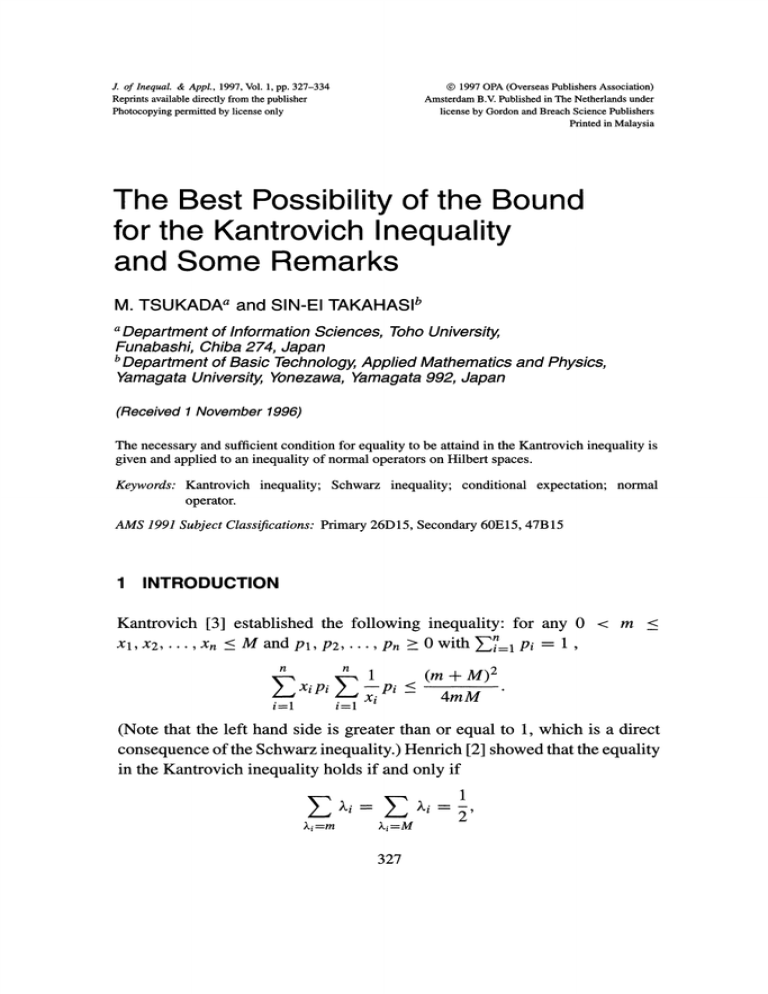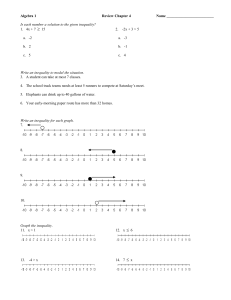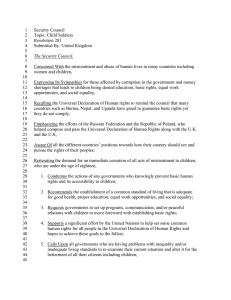Document 10942358
advertisement

J. of Inequal. & Appl., 1997, Vol. 1, pp. 327-334
(C) 1997 OPA (Overseas Publishers Association)
Amsterdam B.V. Published in The Netherlands under
license by Gordon and Breach Science Publishers
Printed in Malaysia
Reprints available directly from the publisher
Photocopying permitted by license only
The Best Possibility of the Bound
for the Kantrovich Inequality
and Some Remarks
M. TSUKADAa and SIN-El TAKAHASI b
Department of Information Sciences, Toho University,
Funabashi, Chiba 274, Japan
b
Department of Basic Technology, Applied Mathematics and Physics,
Yamagata University, Yonezawa, Yamagata 992, Japan
(Received November 1996)
The necessary and sufficient condition for equality to be attaind in the Kantrovich inequality is
given and applied to an inequality of normal operators on Hilbert spaces.
Keywords: Kantrovich inequality; Schwarz inequality; conditional expectation; normal
operator.
AMS 1991 Subject Classifications: Primary 26D15, Secondary 60E15, 47B 15
1 INTRODUCTION
Kantrovich [3] established the following inequality: for any 0 < m <
Xn < M and Pl, P2
Pn >_ 0 with i=ln Pi 1,
X l, X2,...,
n
n
l
1
(m -+- M) 2
xi
4mM
--Pi <
XiPi
i=]
(Note that the left hand side is greater than or equal to 1, which is a direct
consequence of the Schwarz inequality.) Henrich [2] showed that the equality
in the Kantrovich inequality holds if and only if
1
,i=m
,i’--M
327
M. TSUKADA and S.-E. TAKAHASI
328
when m M. Similar to the case for the Schwarz inequality, Kantrovich’s
also has its integral forms. First, Schweitzer [9] showed it for Riemann
integrals, and later Nakamura [5] for Lebesgue-Stieltjes integrals on a
compact space and he also commented out the condition for attaining the
equality.
We here present the Kantrovich inequality for conditional expectations on
probability spaces.
,
..
THEOREM 1 Let (, p) be a probability measure space, a r-subfield
of For any random variables X, Y and Z such that both Y and Z are
-measurable and 0 < Y < X < Z, a.s., the following inequality holds:
1
E(XI)E(-I)
(Y Z) 2
4YZ
+
< --,
a.s.,
.
where E(.I) denotes the conditional expectation with respect to the
cr
subfield
Note that when
{0, g2}, this is the Kantrovich inequality of integral
forms. The proof is inspired by the recent work due to Ptk [7]. There are
two essential points in the proof. One is the inequality between the arithmetic
mean and the geometric mean. The other is the fact that, for any real number
aandxwith0<a-l_<x <a,wehave
x +X -1 <_a+a
This is got from the shape of the graph of y
-
x
+ X -1
If 0 < Y < X <
Z, a.s., then
O<
<
j_y_
_<
a.s.,
and hence we have, using the inequality mentioned above, that
X
,/-Y-
X
<
+
a.s..
KANTROVICH INEQUALITY
329
Therefore
x
JYZ
E(XI)E(I)--E(--I)E(
X
<
I)
[6) + E(
E(
16)
Jrz I)
+
=(zr- x
x
+
< -E(
-4
Ia
2
(Y +
z);
4YZ
holds a.s., where the first and fifth equalities are from the -measurability of
Y and Z, the second inequality is the arithmetic-geometric mean, the fourth
equality is the linearity of conditional expectations, and the fifth inequality
is from the above mentioned.
2 A NECESSARY AND SUFFICIENT CONDITIONS FOR THE
EQUALITY
THEOREM 2 Let (fl, .T, p) be a probability measure space. For any complexvalued random variable X with 0 < m <_ XI <_ M, a,s, the following
inequality holds
ffl,
Xdp
-z-;dp <
(m+M) 2
4mM
The equality is attained if and only if there exists 0 < 0 < 2re such that
p({X
mei})
p({X
Mei})
[
’
I 1,
{
(ifm < M)
(if m M)
M. TSUKADA and S.-E. TAKAHASI
330
The first part of the theorem is a collorary of Theorem 1. Sufficiency of
the second part is obvious, so we prove here necessity. Refering the proof of
Theorem 1 for
{0, 2}, if the equality holds, it must be
j_g_
f
dp
ap
X
\ /----
+
IX[
/l
ap
(m + M) 2
4mM
Therefore
P
IXl
-- -
and hence we have
lXldp
rn
+M
2
+
-[dp
On the other hand because
IXI
/mM + IXl
and
s(,x,
+ IXI
we have
2/-M
+
<
]dp=
mM,
a.s.
+
Hence
(IXI- M)(IXI- m)
that is,
that
0, a.s.,
XI must be equal to rn or M with probability one. It is easy to see
p({IXl
Since the case for rn
m})
M}).
M is trivial, we assume here rn < M. Define
iOm()
x(o)
p({IXI
Me iOM(),
(if IX(o)l
(if IX(o)l
m)
M)
KANTROVICH INEQUALITY
331
and put
f
o
f
ei" dp,
IXI=M
IXl=m
Note that I1, I/1
(m + M)2
4rnM
1/2. Since
1
fx, pf -dp
if(mt+Mfl)(-f -+rn -)
me iOm dp
x
+
f
Me iOi dp
IXI---M
m
Iotl 2 4- Ifll 2 41
ei dp.
ll/me--iOmf
rn
dp +
IXI--M
X
e_iOM
M
dP
afl 4- Mfl
rn
m
M
rn
2+- +--rn
(m + M) 2
4mM
it must be
I1
I1
1/2. Thus
1
eiOMdp
1
IXI-M
We note that these equalities are the special cases of the Schwarz inequality.
Because ofthe possibility of the bound of the inequality, both e i’’ and e i1 are
constant on the sets {IXI m} and {IXl M} respectively. It is easily seen
that these constants must be equal. This completes the proof of the theorem.
By the spectral integral the Kantrovich inequality is generalized to the
inequality for normal operators on Hilbert spaces (cf. 1, 5]).
M. TSUKADA and S.-E. TAKAHASI
332
COROLLARY 3 Let X be a normal operator on a complex Hilbert space
H with 0
m <_ IXI <_ M for some real numbers m, M where
[XI (X’X) 1/2 Then for any unit vector dp
(Xblb)(x-lblb)I
(m + M) 2
4mM
if and only if there exists 0 < 0 < 27r such that
or(X) and
The equality is attained
me i
or(X), Me i
t4,({mei}) t4’({Mei})
(if m < M)
(if m M)
1,
where 004, is the measure on the spectrum or(X) of X corresponding to the
vector state
414) on the commutative C*-algebra generated by 1, X}.
30<A-I<X<A=X+X-I<A+A-I?
Let (A/’, 9) be a noncommutative probability space (i.e., A/" is a von Neuman
algebra and 9 is a faithful normal state on A/" ), and E (.IAA) the conditional
expectation onto avon Neumann subalgebra A4 of A/’. It is interesting
whether or not
E(XI.Ad)E(X-11.A/I) < (Y + Z)2Y-lZ-1/4.
for X ./k/" and Y, Z 6 M with 0 < Y < IXI < z. It is not said in general.
In the proof of Theorem 1 an elementary inequality
O<a -1 < x < a
:= x + x -1
<a
+ a -1
was essential, where a and x are real numbers. In this section we give an
example such that 0 < A-1 < X < A but X + X-1 A + A-1 where A
and X are operators on a Hilbert space.
:
Put
A=
and
(2 0) A_I=(1/2 0)1/2
1__
U=
v’
1
03’
0
KANTROVICH INEQUALITY
333
Then because
A-1
<
0
<
1/2
0 g
<A,
0 2
we have
A-l<
0
0)1/2
<
0)
0
02
<A.
For any ) > 1, put
Xz=U*( 2)0 0)U’
and define
fx()
gx(q)
((A- Xx)qlq},
((Xx A-1)blq).
Because Xx is a Hermitian matrix, fx and gz are real-valued functions. Since
fl and gl are non-negative functions and take 0 only at the origin, these have
positive minimums on the unit circle. Both fz and gz uniformly converge to
fl and g respectively. Therefore if we take ) sufficiently close to 1, we
are able to make
A -1 < Xz < A.
We take
1
Then
((A + A-)1}
2+
,
however
and
1
(2x + =-.)
Thus we have
1
(2 + )
z
-
(z
1
1)(2 + =-.) >
Xx+X ZA+A
-.
o.
334
M. TSUKADA and S.-E. TAKAHASI
References
[1] W. Greub and W. Rheinbold, On a generalization of an inequality of V. Kantrovich, Proc.
Amen Math. Soc., 10 (1954), 407-415.
[2] P. Henrici, Two remarks on the Kantrovich inequality, Amen Math. Monthly, 68 (1961),
904-906.
[3] L.V. Kantrovich, Functional analysis and applied mathematicas (in Russian), Uspechi Mat.
Nauk, 3 (1948), 89-185.
[4] D.S. Mitrinovic, Analytic Inequalities, Springer-Verlag, Berlin, Heiderberg, 1970.
[5] M. Nakamura, A remark on a paper of Greub and Rheinboldt, Proc. Japan Acad., 36 (1960),
19-196.
[6] N. Ozeki and K. Ozeki, Introduction to Inequalities (Japanese), Kindai Kagakusha, Tokyo,
1987.
[7] V. Ptk, The Kantrovich inequality, Amen Math. Monthly, 102 (1995), 820-821.
[8] B.C. Rennie, An inequality which includes that of Kantrovich, Amen Math. Monthly, 70
(1963), 982.
[9] P. Schweitzer, An inequality concerning the arithmetic mean, Hugarian Math. Phys. Lapok,
23 (1954), 257-261.








